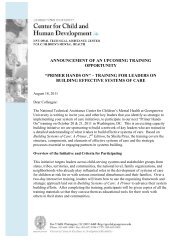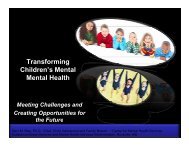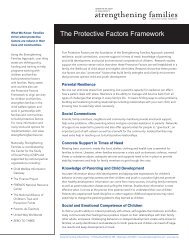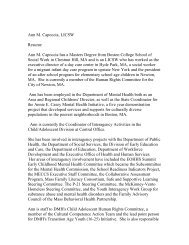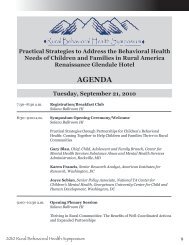Training Institutes 2012 - National Technical Assistance Center for ...
Training Institutes 2012 - National Technical Assistance Center for ...
Training Institutes 2012 - National Technical Assistance Center for ...
Create successful ePaper yourself
Turn your PDF publications into a flip-book with our unique Google optimized e-Paper software.
<strong>Training</strong> <strong>Institutes</strong> 2010<br />
RESOURCES<br />
Definition of Youth-Guided Care<br />
Youth-guided means that young people have the right to be empowered, educated, and given a decision making<br />
role in the care of their own lives as well as the policies and procedures governing care <strong>for</strong> all youth in the community,<br />
state, and nation. This includes giving young people a sustainable voice and then listening to that voice. Youth-guided<br />
organizations create safe environments that enable young people to gain self-sustainability in accordance with the<br />
cultures and beliefs with which they identify. Further, a youth-guided approach recognizes that there is a continuum of<br />
power that should be shared with young people based on their understanding and maturity in a strength-based change<br />
process. Youth-guided organizations recognize that this process should be fun and worthwhile.<br />
YouthMOVE <strong>National</strong>, <strong>2012</strong>. Youth-guided definition. Retrieved from http://youthmovenational.org<br />
MOVING FROM YOUTH-GUIDED TO YOUTH-DRIVEN<br />
YOUTH-GUIDED<br />
Individual • Youth are empowered in their treatment planning process from the beginning and have a voice in decision-making<br />
• Youth receive training<br />
• Equal partnership is valued<br />
Community • Community partners and stakeholders are open and willing to partner with youth and have created safe spaces <strong>for</strong><br />
young people<br />
Policy<br />
• Youth are invited to meetings and training and support is provided<br />
• Youth can speak on their experiences<br />
• Adults value what youth have to say in an advisory capacity<br />
YOUTH-DIRECTED<br />
Individual The young person is:<br />
• Telling his or her story<br />
• Building relationships with people who support them and making decisions in their care<br />
• Developing a deeper knowledge and understanding of the system<br />
• Not in a consistent period of crisis and basic needs are met<br />
Community • Youth have positions and voting power on community boards<br />
• More youth are involved and are recruiting other youth<br />
• Community members respect the autonomy of youth voice and spread the word on the importance of youth voice<br />
Policy • Youth understand policy process and have experience being involved and training<br />
• Youth understand policy issues and speak their opinions<br />
• Youth opinions are heard and action is taken<br />
• There is increased of youth and a decrease in tokenism<br />
YOUTH-DRIVEN<br />
Individual • Youth sets vision and goals <strong>for</strong> treatment with input from team<br />
• Youth is aware of options and is able to utilize and apply knowledge of resources<br />
• Youth is able to stand on own and take responsibility <strong>for</strong> choices<br />
• Youth are mentors and peer advocates <strong>for</strong> other youth<br />
• Youth give presentations based on personal experiences and knowledge<br />
• The youth is making the transition into adulthood<br />
Community • Community partners listen to youth and make changes accordingly<br />
• Young people have a safe place to go and be heard<br />
• Multiple paid positions <strong>for</strong> youth in every decision making group<br />
• Youth <strong>for</strong>m and facilitate youth groups in communities<br />
• Youth provide training in the community<br />
Policy • Youth are calling meetings and setting agendas in policy making<br />
• Youth hold trainings on policy making <strong>for</strong> youth and adults<br />
• Youth in<strong>for</strong>m public about policy and have a position plat<strong>for</strong>m<br />
• Youth lead research to drive policy change<br />
Matarese, M., Carpenter, M., Huffine, C., Lane, S., & Paulson, K. (2008). Partnerships with Youth <strong>for</strong> Youth-Guided<br />
Systems of Care. In B.A. Stroul & G.M. Blau (Eds.) The system of care handbook: Trans<strong>for</strong>ming mental health<br />
services <strong>for</strong> children, youth and families (pp. 275-300). Baltimore: Paul H. Brookes.<br />
163



